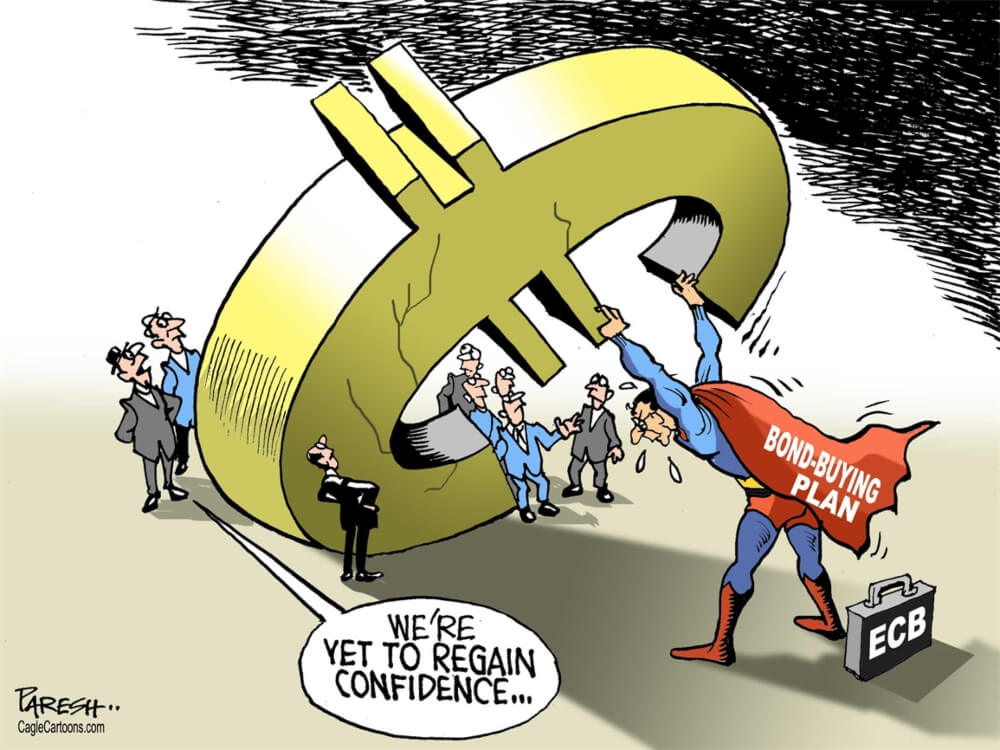
Seis exbanqueros centrales han criticado abiertamente el paquete de estímulos aprobado por el Banco Central Europeo (BCE) en septiembre, sumándose a las opiniones expresadas en las últimas semanas por los presidentes de los bancos centrales de Francia, Alemania, Austria y Países Bajos. En una carta enviada a los medios, los exbanqueros alertan de que están observando "con una preocupación creciente" las decisiones que está adoptando el BCE.
El documento está firmado por los exmiembros del BCE Ottmar Issing y Juergen Stark, que formaron parte del Comité Ejecutivo de la autoridad entre 1998 y 2006 y 2006 y 2011, respectivamente; así como por el exgobernador del banco central de Austria Klaus Liebscher, el expresidente del Bundesbank Helmut Schlesinger, el exgobernador del banco central de Países Bajos Nout Wellink y el antiguo subgobernador del Banco de Francia Herve Hannoun. El exgobernador del Banco de Francia Jacques de Larosiere no figura como firmante de la carta, aunque el documento asegura que comparte las opiniones de sus colegas.
La tasa de inflación
"En los últimos años, el BCE ha alterado 'de facto' la definición inicial de estabilidad de precios al considerar que una tasa de inflación del 1,5% es inaceptable", han criticado los banqueros, tras asegurar que en 1998 se definió la estabilidad de precios como que la inflación anual de la eurozona estuviera por debajo del 2%.
Asimismo, también se han mostrado en contra de la decisión del BCE de situar el tipo de interés de facilidad de depósito en territorio negativo desde hace cinco años. "El BCE justificó en 2014 su política ultraexpansiva, esencialmente, por la amenaza de la deflación. Sin embargo, nunca ha habido un peligro real de una espiral deflacionaria", han apostillado.
"La política monetaria del BCE, por tanto, está basada en el diagnóstico erróneo", han criticado en la carta.
Los exbanqueros consideran que, después de tantos años de compras de activos, no generará ningún efecto positivo el reinicio de las compras netas. "La sospecha de que detrás de esta medida subyace un intento de proteger a gobiernos altamente endeudados de una subida de los tipos de interés se está viendo cada vez más fundada", han alertado. "El BCE ha entrado en el territorio de la financiación monetaria del gasto de los gobiernos, lo que está estrictamente prohibido por el Tratado [de la Unión Europea]", han afirmado.
Art. 123
Queda prohibida la autorización de descubiertos o la concesión de cualquier otro tipo de créditos por el Banco Central Europeo y por los bancos centrales de los Estados miembros en favor de instituciones, órganos u organismos de la Unión, Gobiernos centrales, autoridades regionales o locales u otras autoridades públicas, organismos de Derecho público o empresas públicas de los Estados miembros, así como la adquisición directa a los mismos de instrumentos de deuda por el Banco Central Europeo o los bancos centrales nacionales.
Las críticas dentro del BCE fueron muchas
Los antiguos miembros del BCE han acusado al Consejo de Gobierno actual de estar alimentando una nueva crisis, ya que la búsqueda de mejores rendimientos "aumenta artificialmente el precio de los activos" hasta un nivel que "amenaza con resultar en una corrección abrupta del mercado o incluso una crisis profunda". En septiembre, el gobernador del banco central de Francia, François Villeroy, se mostró en contra de reiniciar las compras netas de activo porque no eran "necesarias".
Unas semanas antes, el presidente del banco central de Alemania (Bundesbank), Jens Weidmann, afirmó que la autoridad presidida por Mario Draghi fue más allá de sus objetivos y que un paquete con tantos estímulos "no era necesario".
De su lado, el presidente del banco central de Austria (Oesterreichische Nationalbank), Robert Holzmann, opinó que las nuevas medidas anunciadas eran un "error", mientras que su homólogo holandés, Klaas Knot, calificó el paquete de "desproporcionado".
Poco más de diez días después de aprobar el paquete de estímulos, la alemana Sabine Lautenschläger decidió dimitir de su cargo en el Comité Ejecutivo del BCE, sin dar ninguna justificación ni explicación. Lautenschläger había sido uno de las voces críticas dentro del Comité Ejecutivo del BCE contra el paquete de estímulos que aprobó la entidad en su reunión de enero.
"Me preocupa fijar incentivos equivocados a los gobiernos si reiniciamos el programa de compra de activos y adquirimos más bonos soberanos. Lo que hace falta son reformas estructurales que fomenten el crecimiento sostenible", aseguró apenas dos semanas antes de que el BCE tomara su decisión de comprar 20.000 millones de euros netos mensuales en activos.
A continuación el texto completo:
The following is a memorandum on the European Central Bank’s monetary policy published on Friday and signed by the people below. Jacques de Larosiere, a former governor of the Bank of France, shared their judgment. The text is reproduced in the original format of their statement.
- Herve Hannoun, former first deputy governor of the Bank of France
- Otmar Issing, former member of the ECB’s Executive Board
- Klaus Liebscher, former governor of the Austrian central bank
- Helmut Schlesinger, former president of Germany’s Bundesbank
- Juergen Stark, former member of the ECB’s Executive Board
- Nout Wellink, former governor of the Dutch central bank
As former central bankers and as European citizens, we are witnessing the ECB’s ongoing crisis mode with growing concern. The ECB has pursued an extremely accommodative policy for years of economic growth and price stability. The recent slowdown in economic activity, although regarded as temporary by the ECB itself, and risks due to Brexit and the trade war, have prompted the ECB to resume net asset purchases and further reduce the already negative deposit rate. Moreover, the ECB has committed itself to pursuing this extremely accommodative path for quite some time yet.
Our concern relates in particular to the following aspects of monetary policy.
- In October 1998, the Governing Council announced its definition of price stability as an average annual increase in the price level for the euro area of below 2 percent. The Council did not change this definition in the 2003 evaluation of its monetary policy strategy at all. In the past few years, the ECB has de facto altered the initial definition of price stability by considering an inflation rate for example of 1.5% as unacceptable. For years now, the ECB has failed to meet its self-imposed target of raising the euro area inflation rate to a level of below, but close to, 2 percent, which in the ECB’s interpretation seems to be a “point target”. The ECB essentially justified in 2014 its ultra-loose policy by the threat of deflation. However, there has never been any danger of a deflationary spiral and the ECB itself has seen less and less of a threat for some time. This weakens its logic in aiming for a higher inflation rate. The ECB’s monetary policy is therefore based on a wrong diagnosis. The frequently used argument that the ECB would be violating its mandate with low inflation rates is simply inaccurate. The Maastricht Treaty enshrines this mandate, according to which the primary objective of the ECB is to maintain price stability.
- Current considerations on defining the 2 percent threshold as a symmetrical inflation target represent a clear departure from a policy focused on price stability. This is particularly true if “symmetry” is understood in the sense that, after years of undershooting the 2 percent mark, a similar period of time should be spent allowing for an overshooting of the 2 percent inflation rate. And, incidentally, how, after years of unsuccessful “inflationary policy”, does the ECB intend to convince the public and the markets that it will succeed in stopping inflation at a certain level in good time?
- There is broad consensus that, after years of quantitative easing, continued securities purchases by the ECB will hardly yield any positive effects on growth. This makes it difficult to understand the monetary policy logic of resuming net asset purchases. In contrast, the suspicion that behind this measure lies an intent to protect heavily indebted governments from a rise in interest rates is becoming increasingly well founded. From an economic point of view, the ECB has already entered the territory of monetary financing of government spending, which is strictly prohibited by the Treaty.
- Negative side effects from very low or negative central bank interest rates was an issue for quite some time. Meanwhile these effects dominate as stressed in the theory of the reversal interest rate, by which the intended effect of very low rates is reversed and becomes contractionary. The negative impact of the ultra-low interest environment extends from the banking system, through insurance companies and pension funds, to the entire financial sector. The re-distribution effects in favour of owners of real assets, create serious social tensions. The young generations consider themselves deprived of the opportunity to provide for their old age through safe interest-bearing investments. The search for yield boosts artificially the price of assets to a level that ultimately threatens to result in an abrupt market correction or even in a deep crisis.
- Extensive loans at extremely low interest rates keep weak banks, and – indirectly through their lending – weak companies, afloat. This is accomplished in particular via Targeted Longer-Term Refinancing Operations (TLTROs), which rose considerably in 2018. The significant negative effects of very low or negative interest rates also include a “zombification” of the economy, which, according to OECD and BIS studies, has already reached a considerable level in some countries and is contributing to weaker productivity growth.
- In extending and further strengthening forward guidance, the ECB is firmly establishing a commitment to ultra-loose monetary policy for the future, thereby substantially impeding the exit from such policy.
A decade ago, the ECB’s monetary policy made a significant contribution to overcoming the severe recession and consolidating growth thereafter. However, the longer the ECB stays its extremely accommodative path, the more the negative effects prevail. Interest rates have lost their steering function and financial stability risks have increased. The longer the ultra-low or negative interest rate policy and liquidity flooding of markets continue, the greater the potential for a setback. Should a major crisis strike, it will be of very different dimensions than those we have seen before. Like other central banks the ECB is threatened with the end of its control over the creation of money. These developments imply a high risk for central bank independence – de jure or de facto.
Memorandum on ECB Monetary Policy by Issing, Stark, Schlesinger

